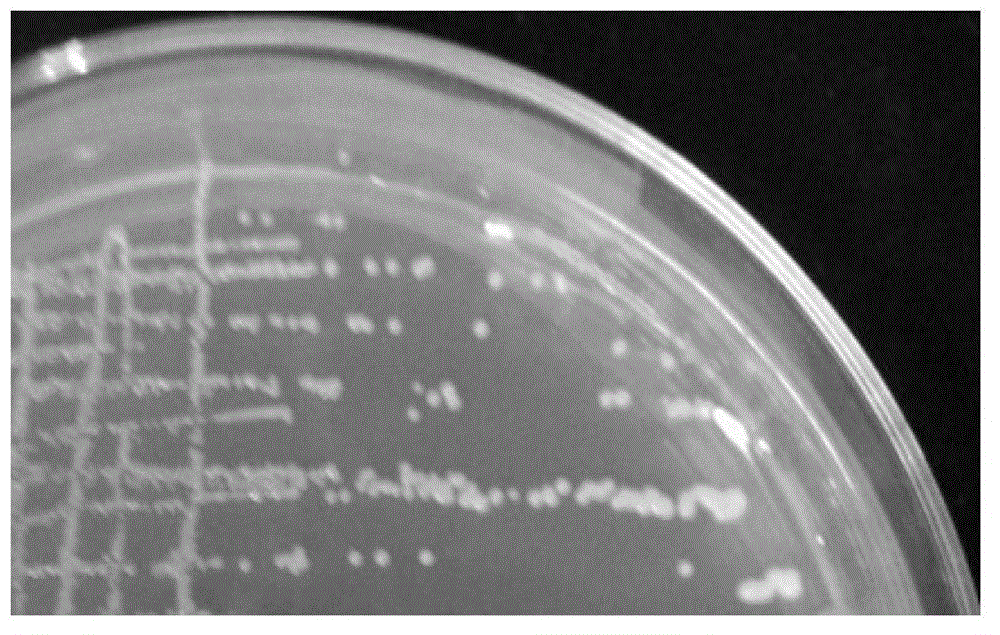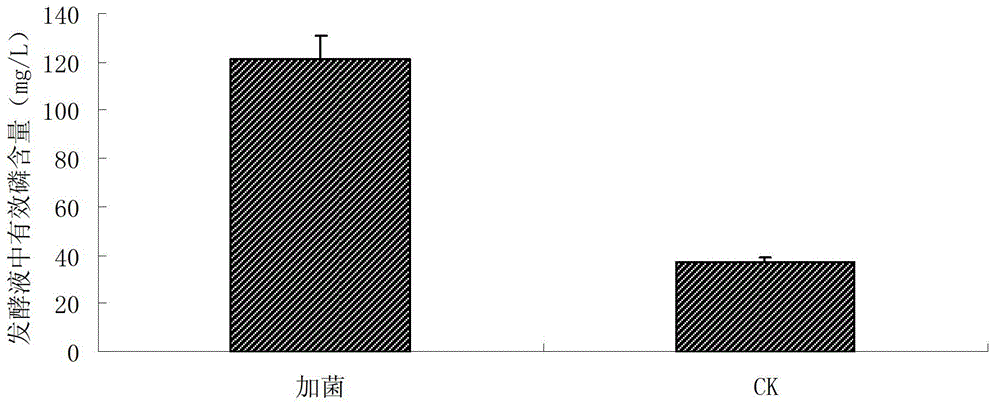Heteroauxin-producing Arthrobacter pascens strain with fluoranthene degradation capacity and application thereof
A technology of indole acetic acid and Arthrobacter, applied in the field of microorganisms
- Summary
- Abstract
- Description
- Claims
- Application Information
AI Technical Summary
Problems solved by technology
Method used
Image
Examples
Embodiment 1
[0030] First prepare the following three media.
[0031] LB medium: peptone 10g, yeast extract 5g, sodium chloride 10g, agar 20g, distilled water 1000ml, pH7.0-7.2, sterilized at 121°C for 20min.
[0032] LB liquid medium: without agar, other conditions are the same as above.
[0033] Inorganic phosphorus bacteria medium (PKO medium): 5g tricalcium phosphate, 10g glucose, 0.5g ammonium sulfate, 0.3g sodium chloride, 0.3g magnesium sulfate heptahydrate, 0.3g potassium chloride, 0.03g manganese sulfate, heptahydrate Ferrous sulfate 0.03g, pH7.0 agar 20g, distilled water 1000ml, pH7.0~7.2. Sterilize at 121°C for 20min.
[0034] Inorganic salt medium: ammonium sulfate 2.0g; sodium dihydrogen phosphate 0.5g; dipotassium hydrogen phosphate 0.5g; magnesium sulfate heptahydrate 0.2g; calcium chloride dihydrate 0.1g, distilled water 1000mL, pH7.0, sterilized at 121℃ , 20min.
[0035] Sieve the rhizosphere soil collected from the foot of Zijin Mountain in Nanjing, weigh 10g and place...
Embodiment 2
[0043] Aerobic test
[0044] Pour the sterilized LB culture medium into 3 sterilized test tubes, at about 2 / 3, on the aseptic operating table, pick up the ZZ21 (CGMCC No.7325) cultured on the slant with an inoculation needle, and puncture Inoculate into the above medium (must be pierced to the bottom of the tube). Cultivate at 30°C, and observe the results in 3 days to 7 days respectively. Those that grow on the surface of the agar column are aerobic bacteria, and those that grow along the puncture line are anaerobic or facultative anaerobic bacteria.
[0045] Determination of catalase
[0046] Put 1 drop of 3% H on a clean slide 2 o 2 , take 1 ring of 18-24h LB slant culture, in H 2 o 2 Smear in the middle, if bubbles are produced, it is positive, otherwise it is negative.
[0047] Methyl red test (M.R test)
[0048] a. Culture medium and reagents: 5g peptone, 5g glucose, 5g sodium chloride, 1000mL distilled water, adjust the pH to 7.0-7.2, divide into test tubes, eac...
Embodiment 3
[0069] In order to further verify the indole acetic acid production ability and optimal conditions of Arthrobacter halotolerant Arthrobacter ZZ21 (CGMCC No.7325) obtained in Example 1, the following is to explore the indole acetic acid production capacity for different pH, liquid volume, different carbon sources, and different nitrogen sources. Effect on acetic acid production.
[0070] Put 15ml, 30ml, 45ml, 60ml, 75ml, 90ml of LB liquid medium containing L-tryptophan (200mg / L) into a 150ml Erlenmeyer flask, and inoculate at a logarithmic After ZZ21 in the growth period, place at 30°C, 180r·min -1 Cultivate on a shaking table for 24 hours, and measure the amount of IAA produced by a quantitative method. The result is as image 3 As shown, due to the facultative aerobic metabolism of the strain ZZ21 (CGMCC No.7325), the aeration rate affects the efficiency of the strain producing IAA. When the amount of liquid is filled, the amount of IAA produced is the largest.
[0071] A...
PUM
 Login to View More
Login to View More Abstract
Description
Claims
Application Information
 Login to View More
Login to View More - R&D
- Intellectual Property
- Life Sciences
- Materials
- Tech Scout
- Unparalleled Data Quality
- Higher Quality Content
- 60% Fewer Hallucinations
Browse by: Latest US Patents, China's latest patents, Technical Efficacy Thesaurus, Application Domain, Technology Topic, Popular Technical Reports.
© 2025 PatSnap. All rights reserved.Legal|Privacy policy|Modern Slavery Act Transparency Statement|Sitemap|About US| Contact US: help@patsnap.com



